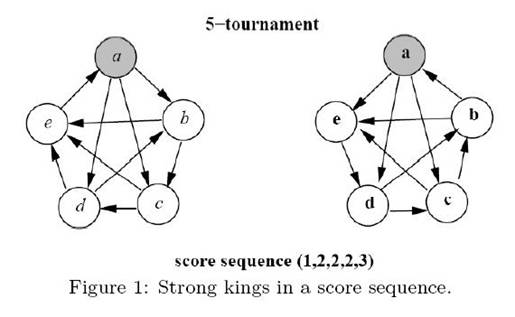解题报告 之 POJ2699 The Maximum Number of Strong Kings
来源:互联网 发布:linux查询ip 编辑:程序博客网 时间:2024/05/21 11:23
解题报告 之 POJ2699 The Maximum Number of Strong Kings
Description
A tournament can be represented by a complete graph in which each vertex denotes a player and a directed edge is from vertex x to vertex y if player x beats player y. For a player x in a tournament T, the score of x is the number of players beaten by x. The score sequence of T, denoted by S(T) = (s1, s2, . . . , sn), is a non-decreasing list of the scores of all the players in T. It can be proved that S(T) = (s1, s2, . . . , sn) is a score sequence of T if and only if 
for k = 1, 2, . . . , n and equality holds when k = n. A player x in a tournament is a strong king if and only if x beats all of the players whose scores are greater than the score of x. For a score sequence S, we say that a tournament T realizes S if S(T) = S. In particular, T is a heavy tournament realizing S if T has the maximum number of strong kings among all tournaments realizing S. For example, see T2 in Figure 1. Player a is a strong king since the score of player a is the largest score in the tournament. Player b is also a strong king since player b beats player a who is the only player having a score larger than player b. However, players c, d and e are not strong kings since they do not beat all of the players having larger scores.
The purpose of this problem is to find the maximum number of strong kings in a heavy tournament after a score sequence is given. For example,Figure 1 depicts two possible tournaments on five players with the same score sequence (1, 2, 2, 2, 3). We can see that there are at most two strong kings in any tournament with the score sequence (1, 2, 2, 2, 3) since the player with score 3 can be beaten by only one other player. We can also see that T2 contains two strong kings a and b. Thus, T2 is one of heavy tournaments. However, T1 is not a heavy tournament since there is only one strong king in T1. Therefore, the answer of this example is 2.


for k = 1, 2, . . . , n and equality holds when k = n. A player x in a tournament is a strong king if and only if x beats all of the players whose scores are greater than the score of x. For a score sequence S, we say that a tournament T realizes S if S(T) = S. In particular, T is a heavy tournament realizing S if T has the maximum number of strong kings among all tournaments realizing S. For example, see T2 in Figure 1. Player a is a strong king since the score of player a is the largest score in the tournament. Player b is also a strong king since player b beats player a who is the only player having a score larger than player b. However, players c, d and e are not strong kings since they do not beat all of the players having larger scores.
The purpose of this problem is to find the maximum number of strong kings in a heavy tournament after a score sequence is given. For example,Figure 1 depicts two possible tournaments on five players with the same score sequence (1, 2, 2, 2, 3). We can see that there are at most two strong kings in any tournament with the score sequence (1, 2, 2, 2, 3) since the player with score 3 can be beaten by only one other player. We can also see that T2 contains two strong kings a and b. Thus, T2 is one of heavy tournaments. However, T1 is not a heavy tournament since there is only one strong king in T1. Therefore, the answer of this example is 2.

Input
The first line of the input file contains an integer m, m <= 10, which represents the number of test cases. The following m lines contain m score sequences in which each line contains a score sequence. Note that each score sequence contains at most ten scores.
Output
The maximum number of strong kings for each test case line by line.
Sample Input
51 2 2 2 31 1 3 4 4 4 43 3 4 4 4 4 5 6 6 60 3 4 4 4 5 5 5 60 3 3 3 3 3
Sample Output
24535
题目大意:有kase组数据。每组数据有一些人两两比赛,告诉你每个人赢得比赛的次数。如果一个人满足它打败了所有分数严格大于它的那个人,则它成为King;当然分数最高的人们自然也都是King。那么请问这场比赛最多能产生多少King呢?
分析:数据规模小的可怜,至多10组数据,每组数据至多10个人。首先明确一个贪心,就是King一定是比分最高的几个人,因为如果比分低的反而是King那么比分比它高的更容易成为King。然后注意的是不确定的输入我的处理办法是用stringstream提取一行即可。
然后我们用最大流的思路来解决。超级源点与所有选手相连,负载为胜利的次数。首先我们要去试探有几个King的时候满足条件,我采用的是二分,由于规模很小,枚举也行。然后在Kings确定了之后,对于每场比赛也看成一个节点,遍历两两选手i,j。如果i是King且score[j]>score[i],说明这场比赛i一定要赢,那么选手i与这场比赛连接,负载为1。如果不满足以上条件则说明此场胜负无所,选手i 、j 都与这场比赛连接,负载为1。最后再让每场比赛与超级汇点连接,负载为1。再跑最大流看看是否最大流=比赛总数n*(n-1)/2。根据结果二分。(枚举的话从低开始往高找,找到一组解即为最优解)。
上代码:
#include<iostream>#include<cstring>#include<algorithm>#include<queue>#include<cstdio>#include<sstream>#include<string>using namespace std;const int MAXN = 210;const int MAXM = 41000;const int INF = 0x3f3f3f3f;struct Edge{int from, to, cap, next;};Edge edge[MAXM];int level[MAXN];int head[MAXN];int score[MAXN];int bigger[MAXN];int src, des, cnt;void addedge( int from, int to, int cap ){edge[cnt].from = from;edge[cnt].to = to;edge[cnt].cap = cap;edge[cnt].next = head[from];head[from] = cnt++;swap( from, to );edge[cnt].from = from;edge[cnt].to = to;edge[cnt].cap = cap;edge[cnt].next = head[from];head[from] = cnt++;}int bfs(){memset( level, -1, sizeof level );queue<int> q;while (!q.empty())q.pop();level[src] = 0;q.push( src );while (!q.empty()){int u = q.front();q.pop();for (int i = head[u]; i != -1; i = edge[i].next){int v = edge[i].to;if (edge[i].cap&&level[v] == -1){level[v] = level[u] + 1;q.push( v );}}}return level[des] != -1;}int dfs( int u, int f ){if (u == des) return f;int tem;for (int i = head[u]; i != -1; i = edge[i].next){int v = edge[i].to;if (edge[i].cap&&level[v] == level[u] + 1){tem = dfs( v, min( f, edge[i].cap ) );if (tem > 0){edge[i].cap -= tem;edge[i ^ 1].cap += tem;return tem;}}}level[u] = -1;return 0;}int Dinic(){int ans = 0, tem;while (bfs()){while (tem = dfs( src, INF )){ans += tem;}}return ans;}int main(){int kase;cin >> kase;getchar();src = 0; des = 105;while (kase--){int n = 0;string str;getline( cin, str );stringstream ss( str );int sc;while (ss >> sc){score[++n] = sc;}bigger[n] = 0;for (int i = n - 1; i >= 1; i--){if (score[i] == score[i + 1]) bigger[i] = bigger[i + 1];else bigger[i] = n - i;}int start;for ( start = 1; start <= n; start++){if (score[start] >= bigger[start])break;} int low = start, high = n;int ans = start;while(low<=high){int mid = (low + high) / 2;memset( head, -1, sizeof head );cnt = 0;int match = 0;for (int i = 1; i <= n; i++){addedge( src, i, score[i] );}for (int i = 1; i <= n; i++){for (int j = i+1; j <= n; j++){if (i >= mid&&score[j] > score[i])addedge( i, (++match) + 50, 1 );else{addedge( i, (++match) + 50, 1 );addedge( j, match + 50, 1 );}}}for (int i = 1; i <= match; i++){addedge( i + 50, des, 1 );}if (Dinic() < (n*(n-1))/2) low = mid + 1;else{ans = mid;high = mid - 1;}}cout << n - ans + 1 << endl;}return 0;}洗个澡开始开黑啦~~拜拜
0 0
- 解题报告 之 POJ2699 The Maximum Number of Strong Kings
- #poj2699 The Maximum Number of Strong Kings
- poj2699 The Maximum Number of Strong Kings
- POJ2699 The Maximum Number of Strong Kings (maxflow)
- 【POJ2699】The Maximum Number of Strong Kings 枚举(二分)+网络流check、
- POJ 2699 The Maximum Number of Strong Kings
- poj 2699 The Maximum Number of Strong Kings
- poj 2699 The Maximum Number of Strong Kings 网络流
- POJ 2699 The Maximum Number of Strong Kings(最大流)
- POJ 2699 The Maximum Number of Strong Kings
- POJ 2699The Maximum Number of Strong Kings(最大流)
- POJ 2699 The Maximum Number of Strong Kings 最大流
- Poj2699The Maximum Number of Strong Kings
- POJ 2699 The Maximum Number of Strong Kings(最大流)
- POJ 2699 The Maximum Number of Strong Kings 网络流 竞赛图
- POJ 2699 The Maximum Number of Strong Kings 竞赛图+最大流
- [省选前题目整理][POJ 2699]The Maximum Number of Strong Kings(暴力枚举+最大流)
- POJ 2699 - The Maximum Number of Strong Kings(网络流‘最大流)
- 多继承(含虚函数覆盖)vftb中虚函数排列
- 用Python和Pygame写游戏-从入门到精通(5)
- git解决冲突与merge
- cocos2d创建带有背景颜色的layer
- 天津网站建设-SEO
- 解题报告 之 POJ2699 The Maximum Number of Strong Kings
- 【Python】豆瓣FM API分析
- Android开发——Activity间的值传递
- 遗留代码
- HTML5数据推送SSE原理及应用开发
- 基于nrf51822的蓝牙低功耗温湿度节点设计
- 对话框窗口最大最小化
- 自己写的一个除法小程序
- Java对象的序列化和反序列化


